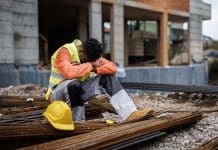
The built environment is at high risk of modern slavery due to skills shortages, a widespread reliance on temporary migrant workers and tight deadlines. Emma-Jane Allen, senior consultant at Action Sustainability and lead of the Built Environment Against Slavery Group at the Supply Chain Sustainability School discusses a new toolkit designed to help businesses of all sizes combat labour exploitation head-on
Did you know that over 100,000 victims of modern slavery are estimated to exist right here in the UK, with construction considered one of the higher-risk industries? This shocking reality often goes unnoticed, yet finding instances of slavery or labour exploitation on our sites is now a matter of ‘when’, not ‘if’.
Some construction companies dismiss concerns about slavery risks on their sites or in their supply chains, citing: “We only work with reputable companies”, “Our onboarding processes are thorough”, “We would never use slave labour” or “Our policy explicitly states zero tolerance for modern slavery”.
However, these assertions don’t eliminate risks. Organised crime gangs use sophisticated techniques to infiltrate businesses.
Operation Cardinas – one of the UK’s largest modern slavery investigations, illustrates how a criminal gang placed hundreds of victims of forced labour into major construction sites across London and the South East, with more than 33 contractors, agencies and umbrella firm payroll providers being infiltrated.
So rather than denying the problem exists, good practice modern slavery due diligence is about recognising and addressing these risks head-on.
Why is construction considered high risk for slavery and labour exploitation?
Contributing factors include ongoing labour and skills shortages leading to widespread use of temporary migrant labour, agency labour and complex subcontracting supply chains.
Earlier this year, the Gangmasters & Labour Abuse Authority (GLAA) issued a warning that the recent increase in construction shortage occupation visas granted further heightens the risk of slavery and labour exploitation in our sector.
Low profit margins and tight deadlines can lead to businesses ignoring usual protocols for bringing workers on to sites. Meanwhile, ethical labour audits continue to highlight issues such as workers not receiving written terms and conditions and facing unexpected wage deductions.
Empowering the construction industry to combat modern slavery
In response to these risks, Action Sustainability has published a free Operational Toolkit through the Supply Chain Sustainability School’s Built Environment Against Slavery Group. This practical, easy to navigate resource supports businesses of all sizes with their modern slavery due diligence.
The toolkit empowers those involved in site set up and management to effectively combat slavey and labour exploitation. It focuses on six key risks, including the lack of awareness of the prevalence of slavery and labour exploitation in the UK and of the sophisticated techniques that exploiters use to infiltrate businesses, workers not knowing how, or why, they should report any concerns, cultural and language barriers, and workers not being aware of their basic entitlements.
For each risk, the toolkit provides actionable insights and recommendations to manage and mitigate these risks, along with free resources to help like posters, toolbox talks and awareness videos.
Beyond compliance
The challenge for businesses extends beyond mere compliance with the Modern Slavery Act 2015 – for instance, a business can be compliant even with a modern slavery statement that says it has taken no steps to combat slavery.
We need to shift away from the mindset that modern slavery is someone else’s problem or only relevant to specific roles. We need to integrate modern due diligence into our standard operating procedures, much like health and safety protocols. This means taking proactive measures to prevent, identify, manage and mitigate the risks of modern slavery and labour exploitation through our operations and supply chains.
This Operational Toolkit empowers those on the frontlines of site management to do just this.
By embedding these practices into “business as usual” site set up and management, companies can enhance accountability and transparency. This approach not only aligns with ethical responsibilities but also mitigates legal, financial and reputational risks associated with modern slavery and labour exploitation.
Jo Potts, sustainability director at Balfour Beatty and co-chair of the Built Environment Against Slavery Group, said: “Operating responsibly and with integrity while upholding the highest ethical standards is critical to success – it must be at the heart of how the construction and infrastructure industry conducts business. It is therefore integral that we empower our people to tackle modern slavery.
“By equipping our teams with the necessary tools and knowledge, we can significantly reduce the risks of exploitation within our projects and across our supply chain.”













